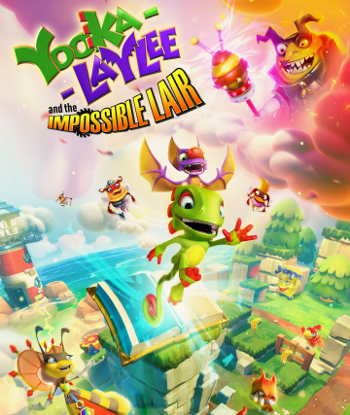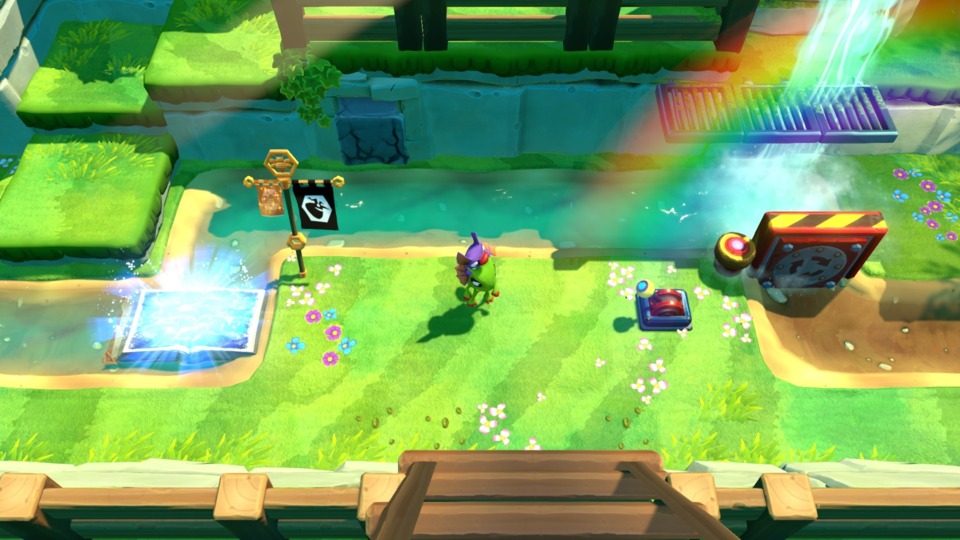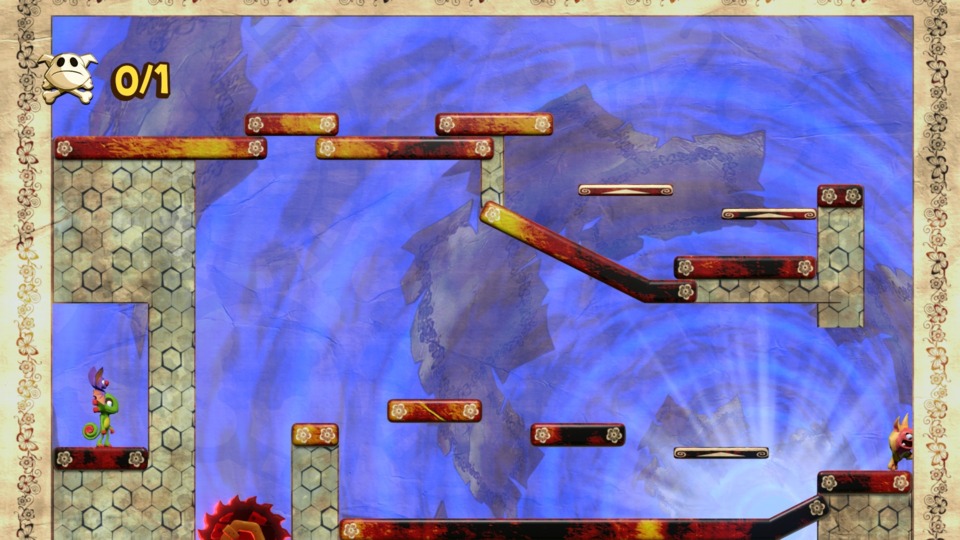
Something I planned to do in the new year once my Game Pass had expired was to revisit a bunch of games I'd previously disqualified for having specs too high for what was, and let's be kind here, a distressed piece of cardboard someone had drawn a crude facsimile of a laptop onto with that someone being me. The original Yooka-Laylee ran just fine on that laptop but its 2019 sequel not so much, made all the odder by the fact that the original was a fully 3D game to this one's purely 2D side-scrolling format. However, the limited perspective change is really only a mechanical consideration: Yooka-Laylee and the Impossible Lair is every bit the sumptuous polygonal game as its forebear, just opting to take a slightly different approach to its level design. While the first was a dyed-in-the-wool 3D collectathon in the guise of Yooka-Laylee's not-so-hidden inspiration Banjo-Kazooie, Impossible Lair feels like the series taking a more Donkey Kong Country (Returns) route (which, given developer Playtonic's background as ex-Rare people, has some kind of logical process behind it).
Yooka-Laylee and the Impossible Lair sees the chameleon and bat team take on their old nemesis Capital B but get quickly trounced by the ludicrously tough final dungeon he's built, the titular lair. However, local deposed monarch Queen Phoebee has a suggestion: if Yooka and Laylee can rescue her martial subjects, the Beetallion, they can provide support in the Impossible Lair by taking hits for the team. Essentially, you're working to give yourself up to an additional 48 hit points for the game's final gauntlet if you do the legwork in rescuing them all. The game's masterstroke is that it has an overworld map with twenty levels on it; however, each of those levels can be messed with in some way on the overworld in order to change them to a harder variant. The overworld is thus packed with puzzles to solve in order to change the nearby stage's state: this might mean flooding the area by diverting water to turn it into an underwater stage; tossing a cool berry on it to become an ice stage; switching on or off a bunch of machines to change the stage's pace; and so on. Consider the clock level in Super Mario 64 and how, by entering the level at different times on the clockface, the level itself would undergo considerable changes (or, for an example closer to home, Click Clock Wood of Banjo-Kazooie and the massive shifts between seasons). A third example would be the comet levels in the Super Mario Galaxy games, which mix things up with new and tougher challenges in otherwise familiar stages. While the level geography stays largely the same between variants, the shifts often make the same sequences harder to complete and have a tougher assortment of enemy placements and hazards to contend with. These levels are all invariably tough linear courses with a handful of coin collectibles per stage (and both stage variants have their own sets of those as well) but have a potent degree of variety to the obstacles in the player's path, which tend to be exaggerated further still in the alternative versions. The devs clearly reached further back to their DKC days for many of the ideas that went into these levels, including some well-hidden secrets and platforming sequences that revolve around particular gimmicks or themes to set themselves apart from the others. The one thing I've not encountered yet after beating roughly half the game are bosses, but it might be for the best given how much trouble I had with them in Tropical Freeze (whoever heard of a Nintendo platformer with a "rule of nine"?).

Aesthetically, the game has the same polish Yooka-Laylee did, with bright and colorful worlds backed with the thoroughly wholesome tunes of veteran Rare composers Grant Kirkhope and David Wise (along with Matt Griffin and Daniel Murdoch). Yooka's the earnest hero while Laylee is the wisecracking, often fourth-wall-breaking grump riding on Yooka's back. Laylee has something of an odd role in the game, acting as she does as the permanent non-active player: when Laylee is around, the player can twirl in the air and perform ground-pounds, both of which are often essential for collectibles but tend to be useful for basic platforming as well. If you get hit, Laylee flies off in a panic, giving you a few seconds to catch her and calm her down before she bails on you; chasing after her often puts you in risk of quickly taking a second hit, however, which without Laylee is a fatal blow that resets you to the last checkpoint. A Laylee that's run off can be recovered in much the same way the secondary Kongs are in DKC, though instead of a replacement barrel it's a bell to summon her back. Levels can be completed without her but as she's a useful helper and a safety net both, it behooves the player to keep her around as much as possible. Dying trying to catch a frantic Laylee is probably the most common cause of death of yours truly, maybe second only to trying to pick up a collectible the wrong way because I didn't realize there was an invisible cannon or something that would shoot me straight to it.
The overworld might be one of the most elaborate I've seen in a game of this type, and is less a fancy world map than it is like the overworlds of the Zelda games: a huge, open zone full of secrets to find and puzzles to solve that require some futzing around with in order to reach all the levels and, in particular, all those alternative levels. Rather than the coin collectibles you find in stages, the overworld collectibles are tonics: these potions act as modifiers when you equip them while entering a stage, giving you all sorts of bonuses in exchange for a lower haul of the quill currency (mostly used for buying new tonics, ironically enough). The tonics can also offer maluses as well, and conversely these boost your quill income after levels instead; by mixing and matching with the three slots available, you can find a balance of bonuses and maluses that ensures a decent payout of quills while giving you the advantages you want and the disadvantages you can handle. The game also has a ton of tonics that simply do something weird with the graphics, like visual filters or making Yooka-Laylee's head really big (an old Rare staple). These, naturally, won't affect your quill haul one way or the other. The game is full of details to discover and the levels themselves are so packed with little risk vs. reward opportunities that they're often a joy to explore, though just as often they'll make you frustrated when you find a collectible out of sequence and realize you'll need to revisit the stage to acquire them all (as the stage are very linear, there's a lot of one-way doors and the like). It also has my least favorite of modern accessibility features which is the condescending checkpoint offering to let you skip that part of the game because you clearly suck at it. Gee, thanks for the vote of confidence.

I think this second Yooka-Laylee is pretty solid and certainly a step up from the previous game. I'm always going to love open world collectathons over linear gauntlet-style levels in general but Yooka-Laylee clearly had some kinks to work out in their first foray and by switching formats for the sequel it's managed to work those kinks out while finding a new venue for its imaginative feature ideas and the developers' many years of experience. The level-altering tricks are an ingenious way to reuse a lot of assets in a manner that feels fresh and challenging rather than repetitive, the platforming is decent enough once you get used to the roll + jump + hover technique to get across bigger gaps (though DKC fans will pick it up quickly), it's visually and aurally a treat, and it's certainly not a short game: even with twenty levels (expanded to forty with the alternative modes) there's enough content to keep you busy for a dozen plus hours at least. Pretty solid package all around, and now we're four years removed I'm curious if any more Yooka-Laylee is on the way (Playtonic seems happy enough to be an Indie publisher at the moment, including another 3D platformer I want to get around to soon called Demon Turf, but here's hoping they get back into developing soon).
Rating: 2 out of 5.
Post-Playthrough Edit: Originally scored this a 4, but downgraded to a 2 once the true misery of the titular final gauntlet made itself known. Too difficult and too long by half, it also highlights all the issues I've had with the game's technical prowess or lack thereof regarding shaky enemy and platform collision and input lag. Some games you power through even when they show their entire ass to you because there's a kernel of creativity that you admire and root for, but others double-down on creating scenarios where all the flaws are made manifest and you can't help but lose all affection for what would've been a scrappy contender in a space not yet known for lavish 3D platformers (though in the fixed 2D sense). Not recommended, sadly.
| < Back to 310: F.I.S.T.: Forged in Shadow Torch | 001-100 | 101-200 | 201-300 | > Forward to 312: Mutant Year Zero: Road to Eden |

Log in to comment